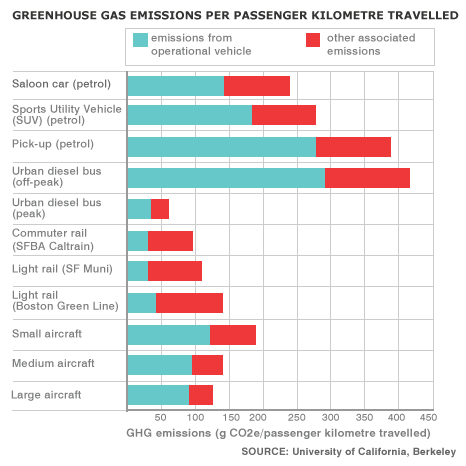Kibunango
Platinum Member
- Aug 29, 2006
- 8,420
- 2,271
Policymakers must consider more than just "tailpipe" emissions when assessing the impacts of different modes of transport, say researchers.
Many analyses overlook greenhouse gases emitted in constructing and maintaining travel infrastructures, they added.
The team found that, based on passenger kilometres travelled, off-peak urban bus services were more carbon-intensive than flights by commercial aircraft.
The findings have been published in the journal Environmental Research Letters.
The researchers from the University of California, Berkeley, said the importance of tackling emissions from transport meant that decisions should not be based on partial data.
"Governmental policy has historically relied on energy and emission analysis of automobiles, buses, trains and aircraft at their tailpipe," they wrote.
"[This ignores] vehicle production and maintenance, infrastructure provision and fuel production requirements to support these modes.
"To date, a comprehensive life-cycle assessment (LCA) of passenger transportation in the US has not been completed."
Hidden emissions
The team selected a range of transport to be assessed, including a saloon car, an urban bus service and a mid-sized aircraft.
They then identified ways in which energy was being used and/or gases were being emitted.
As well as assessing "operational components", such as the fuel consumption of running an engine, the team also considered the impacts of "non-operational components", such as road construction, street lighting and maintenance.
The data was then presented in terms of grams of carbon dioxide equivalent per passenger kilometre travelled (g CO2e/PKT) to allow a comparison between the different modes' carbon intensities.

More at BBC NEWS
Many analyses overlook greenhouse gases emitted in constructing and maintaining travel infrastructures, they added.
The team found that, based on passenger kilometres travelled, off-peak urban bus services were more carbon-intensive than flights by commercial aircraft.
The findings have been published in the journal Environmental Research Letters.
The researchers from the University of California, Berkeley, said the importance of tackling emissions from transport meant that decisions should not be based on partial data.
"Governmental policy has historically relied on energy and emission analysis of automobiles, buses, trains and aircraft at their tailpipe," they wrote.
"[This ignores] vehicle production and maintenance, infrastructure provision and fuel production requirements to support these modes.
"To date, a comprehensive life-cycle assessment (LCA) of passenger transportation in the US has not been completed."
Hidden emissions
The team selected a range of transport to be assessed, including a saloon car, an urban bus service and a mid-sized aircraft.
They then identified ways in which energy was being used and/or gases were being emitted.
As well as assessing "operational components", such as the fuel consumption of running an engine, the team also considered the impacts of "non-operational components", such as road construction, street lighting and maintenance.
The data was then presented in terms of grams of carbon dioxide equivalent per passenger kilometre travelled (g CO2e/PKT) to allow a comparison between the different modes' carbon intensities.

More at BBC NEWS